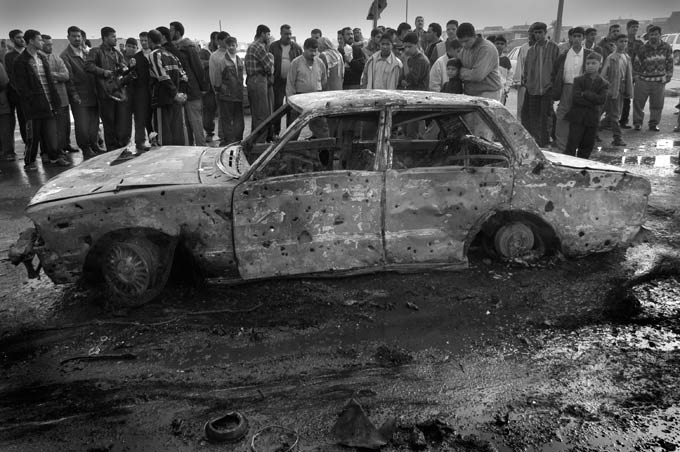
Baghdad. Iraqi civilians gather around a car destroyed in an insurgent bombing, 2003. Photo by Teru Kuwayama.
In the spring of 2003, I flew into Amman, and drove across the Jordanian border into Iraq. Saddam Hussein’s regime had collapsed a few weeks earlier, and a handful of bemused American soldiers who were stationed at the border crossing shrugged their shoulders and waved my vehicle across into the desert.
I spent the next month in Baghdad, wandering the streets with a toy camera, photographing a visibly traumatized population as it emerged from decades of terror under a sociopathic tyrant—into the chaos of “freedom.”
Scavengers, on the trail of looters, stripped scrap metal from the ruins of ministries, and civilians unearthed mass graves in search of relatives. Checkpoints, fuel lines and piles of uncollected garbage choked the streets.
I accompanied U.S. forces as they extracted truckloads of cash from bank vaults that had survived the looters, and as they transformed Saddam Hussein’s palaces into armored bastions of plywood and concrete.
President Bush would soon declare that “major combat operations in Iraq have ended,” but as the United States would slowly learn over the months and years that followed, it was only beginning.
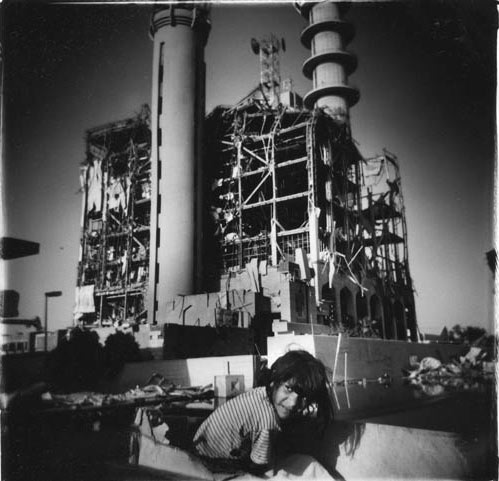
Baghdad. A young girl at play in front of the ruins of the telecommunications ministry building, destroyed by a U.S. airstrike, 2003. Photo by Teru Kuwayama.
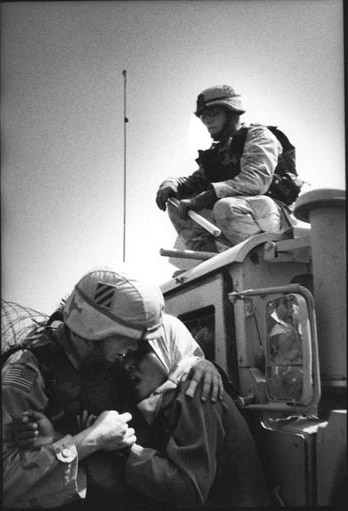
Baghdad. A female U.S. soldier comforts a young Iraqi girl who has broken down in tears, 2003. Photo by Teru Kuwayama.

A U.S. soldier on patrol through the streets of Baghdad at night, 2003. Photo by Teru Kuwayama.
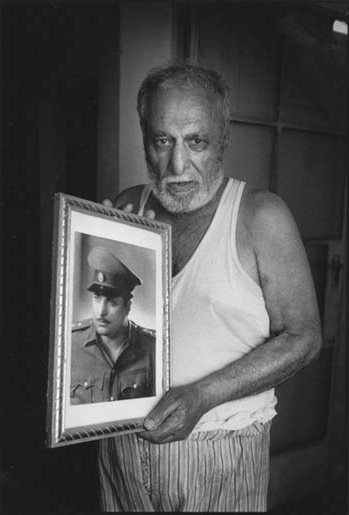
Baghdad. An Iraqi civilian holds a portrait of himself as a young police officer in a bygone era when Iraq was a prosperous country, 2003. Photo by Teru Kuwayama.
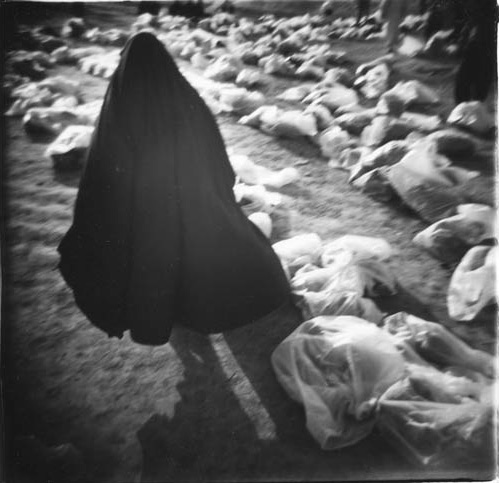
Al-Hillah, Iraq. A Shia woman, dressed in Abaya, moves through a field of body bags. After the fall of the Saddam regime, civilians began to unearth mass grave where Iraqis had been murdered by the regime. For the first time they were able to search for the bodies of their loved ones. 2003. Photo by Teru Kuwayama.

A U.S. soldier on patrol through the streets of Baghdad at night, 2003. Photo by Teru Kuwayama.

Baghdad. A U.S. soldier moves through the ruins of one of Uday Hussein’s palaces, destroyed in a U.S. airstrike, and later appropriated for use by the Coalition Provisional Authority, in what would become known as the Green Zone, 2003. Photo by Teru Kuwayama.
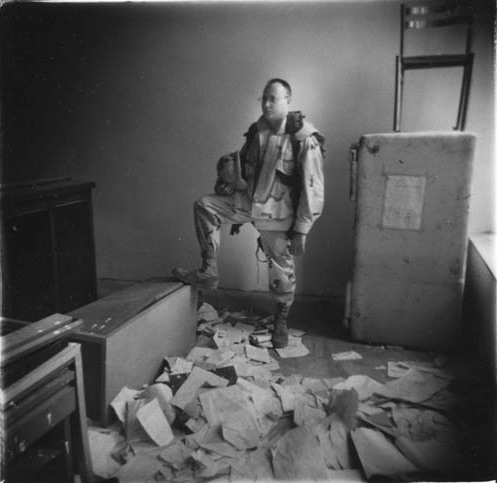
A U.S. Army reservist, who worked in the financial industry in Chicago before being called up, stands in the ruins of a looted Iraqi bank in Baghdad, 2003. Photo by Teru Kuwayama.
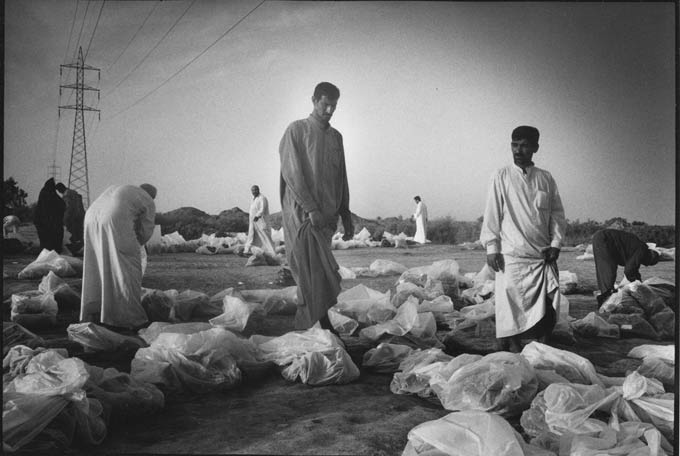
Al-Hillah, Iraq. Shia Iraqi search through a field of body bags. After the fall of the Saddam regime, civilians began to unearth mass grave where Iraqis had been murdered by the regime. For the first time they were able to search for the bodies of their loved ones. 2003. Photo by Teru Kuwayama.
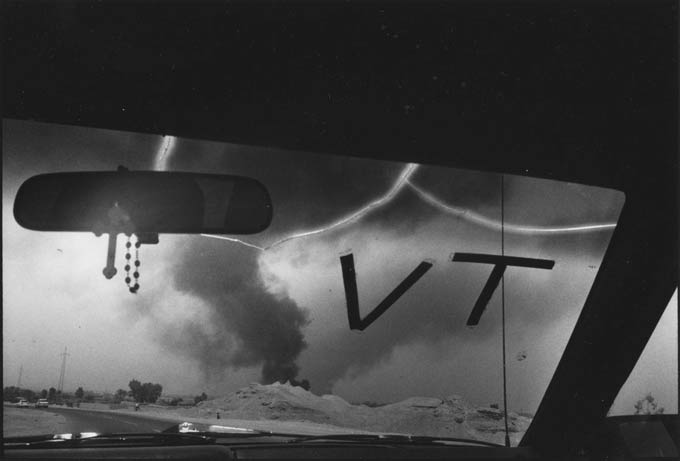
Location unknown, near Baghdad. A car used by journalists drives past a burning oil pipeline that was attacked by insurgents. The Iraqi Christian driver’s crucifix hangs from the rear view mirror, and “TV” is taped to the windshield to identify the vehicle as belonging to foreign media. At that point, coalition airstrikes were a greater fear than banditry or kidnapping. 2003. Photo by Teru Kuwayama.
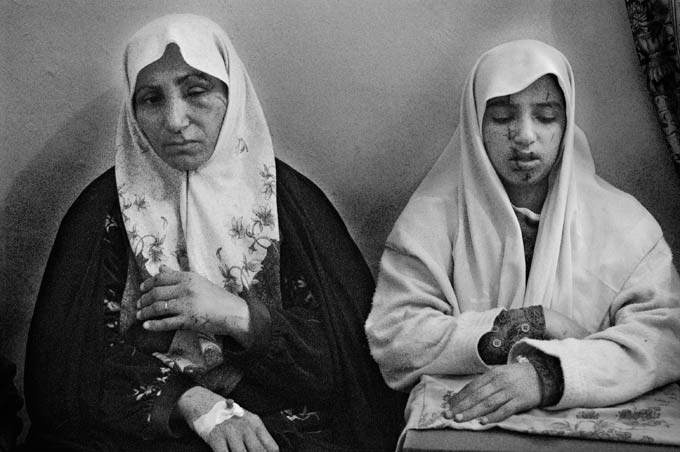
Karbala. A mother and daughter, wounded by flying glass from a car bomb that exploded as they walked to school. The family’s second child was in another room in critical condition with severe head wounds. 2003. Photo by Teru Kuwayama.
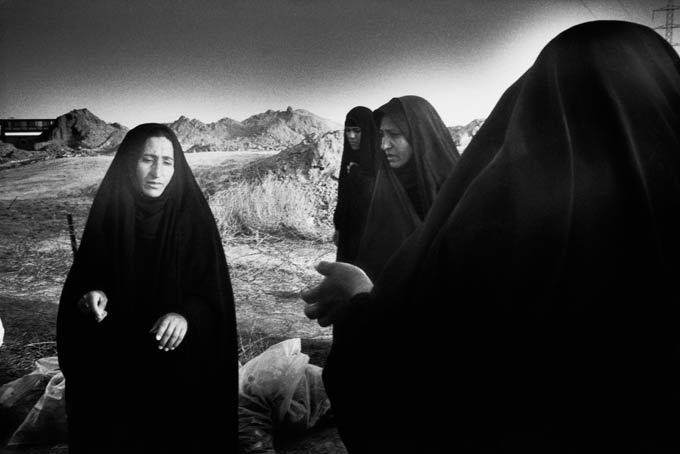
Shia women, dressed in Abaya, gathered in a field of body bags. After the fall of the Saddam Hussein regime, civilians began to unearth mass grave where Iraqis had been murdered by the regime. For the first time they were able to search for the bodies of their loved ones. 2003. Photo by Teru Kuwayama.
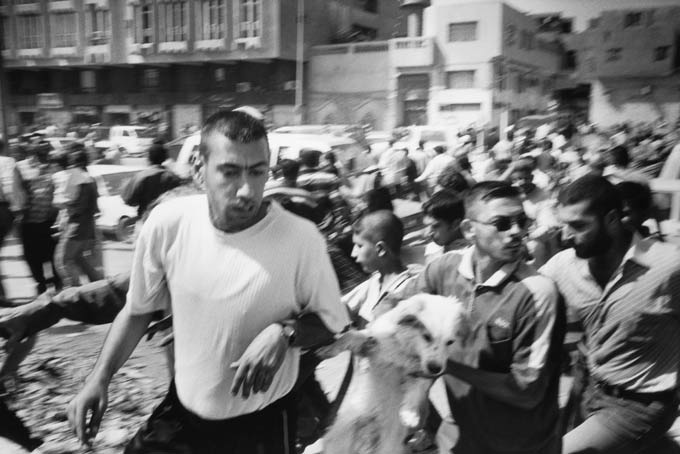
Baghdad. As a gunfight breaks out, civilians flee from a market where animals are sold, 2003. Photo by Teru Kuwayama.
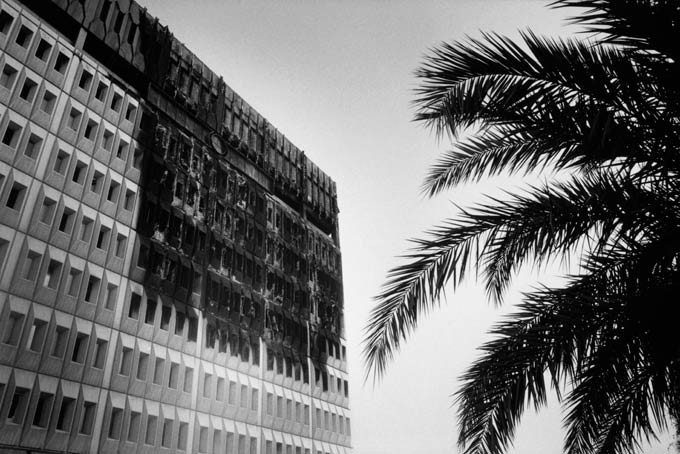
Baghdad. Iraq’s Ministry of Water, burned by looters in the aftermath of the fall of Saddam Hussein’s regime, 2003. Photo by Teru Kuwayama.
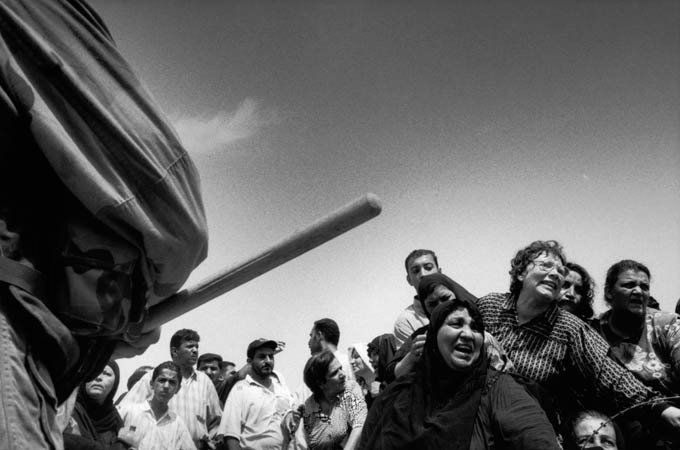
Baghdad. U.S. soldiers hold back Iraqi civilians who have gathered outside a government office where pensions were distributed, 2003. Photo by Teru Kuwayama.
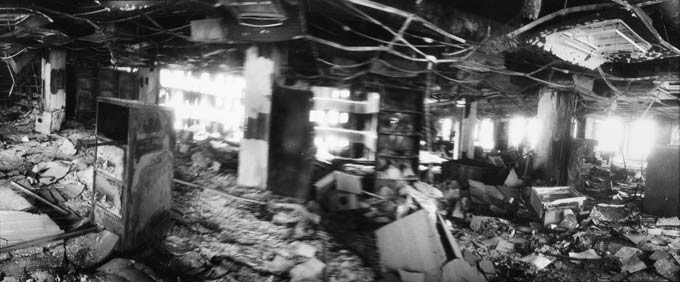
Baghdad. The ruins of the Ministry of Education, which was looted and burned in the aftermath of the collapse of Saddam Hussein’s regime, 2003. Photo by Teru Kuwayama.
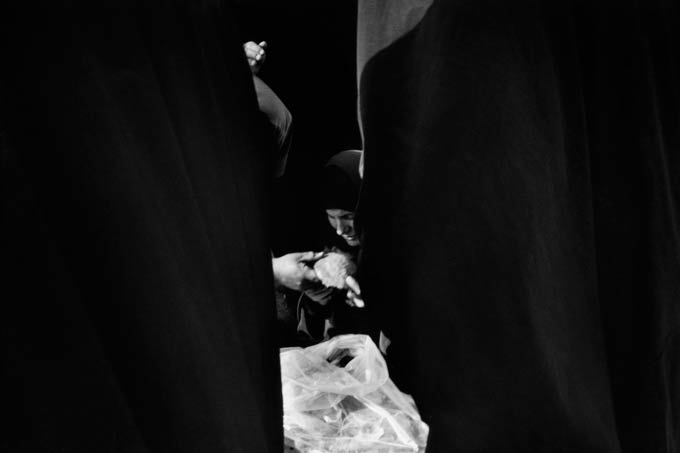
A Shia woman, dressed in Abaya, holding a skull fragment. After the fall of the Saddam Hussein regime, civilians began to unearth mass grave where Iraqis had been murdered by the regime. For the first time, they were able to search for the remains of their loved ones. 2003. Photo by Teru Kuwayama.
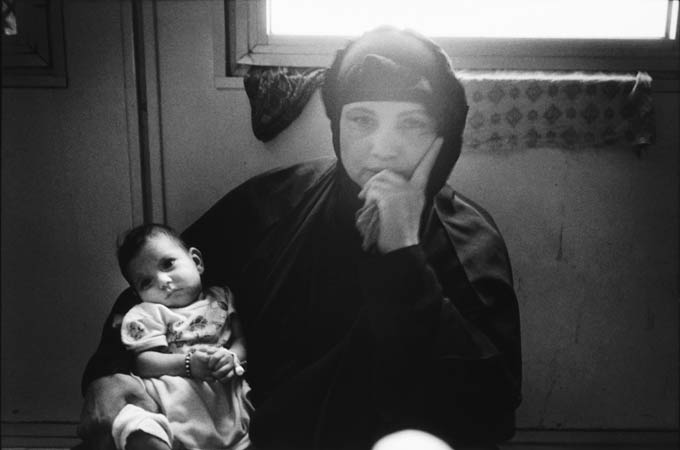
An Iraqi woman holds her dying infant in a hospital in Baghdad. Medical supplies were running low and the hospital had only a few days’ supply of the medicine that her child required. 2003. Photo by Teru Kuwayama.
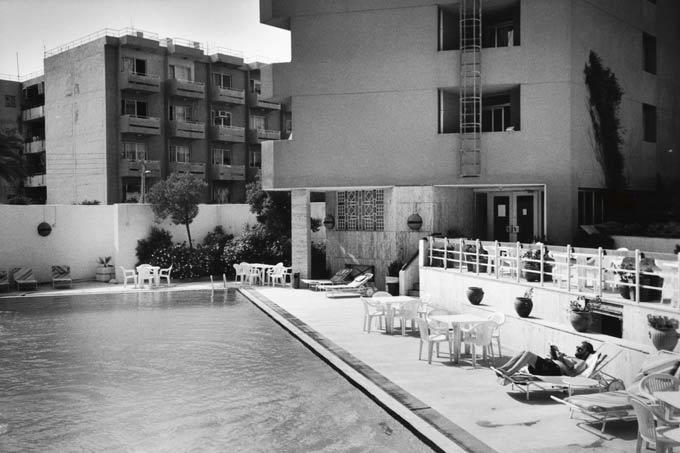
An American journalist reads an out-of-date tourist guide to Iraq, by the pool of the Al-Hamra hotel in Baghdad, 2003. Photo by Teru Kuwayama.
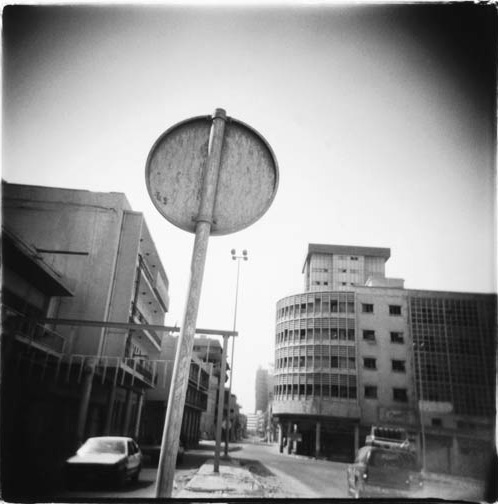
Al Rasheed Street, one of Baghdad’s main commercial thoroughfares, deserted in the days following the collapse of the Saddam Hussein regime, 2003. Photo by Teru Kuwayama.

A movie theater resumes operations in Baghdad, one of the first businesses to reopen after the collapse of the Saddam Hussein regime, 2003. Photo by Teru Kuwayama.

